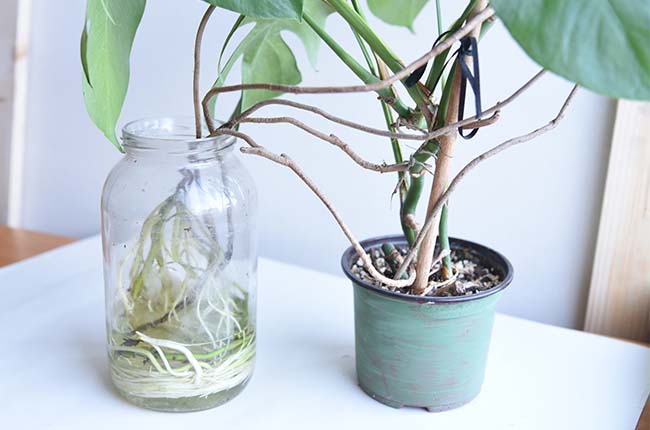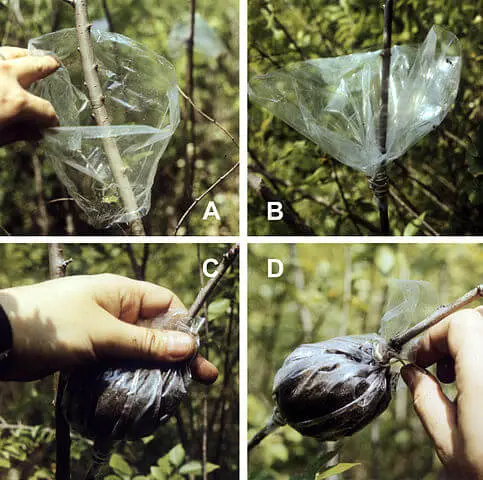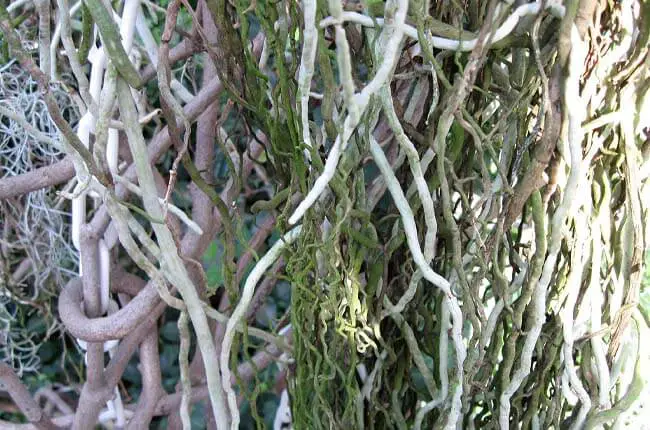No wonder why many people want to grow aerial roots on their houseplants, orchids, bonsai, and even succulents. Not only do they add a special look to the plant, but they also help absorb moisture and nutrients in the air, and stabilize the plant.
So how do you stimulate aerial roots?
The natural approach is the easiest by increasing the plant’s need for moisture and providing a hot, humid environment with good soil drainage. The greenhouse method can be used to trap moisture around the plant. For plants with woody stems, the more advanced techniques of air layering and root grafting can be applied.
To learn more about each of these four approaches suitable for your plant, let’s get started.
1. Natural approach
Some people believe that the plant must be root bound in the soil or that the plant must be old to grow aerial roots. But these are not necessarily true. In fact, when under certain conditions, the plant will start growing aerial roots on its own.
The natural conditions optimal for growing aerial roots are:
1.1 Abundant leaves and soil roots
Sufficient leaves and soil roots are essential if your plant needs to develop aerial roots.
While a dense foliage generates a higher need for moisture and nutrients, an abundance of soil roots creates a sense of dissatisfaction in the plant with the existing moisture condition as the roots absorb all the water in the soil.
A combination of these two factors would thus force the plant to grow aerial roots above ground to find moisture in the air.
And to achieve a dense foliage, it is better to avoid pruning and let it grow.
1.2 Enough light
Similar to the need for leaves, sufficient light is important for the plant to absorb water in order to carry out photosynthesis. You can expose the plant to direct sunlight, though not necessary.
1.3 Soil with good drainage
Soil with good drainage has a large space between the particles. It helps the roots absorb water faster, thus drying up the soil faster and increasing the need for finding moisture in the air.
1.4 Hot and humid environment
A hot and humid environment that ranges between 85-105 Fahrenheit (or 30-40 Celcius) is ideal for growing aerial roots naturally.
If the air is dry, you can compensate by misting two to three times a day, wrapping the plant around with a plastic bag, or putting it in a greenhouse as explained below.
2. Greenhouse method
If your growing environment is not humid enough, the “greenhouse method” is basically a natural approach to stimulate root growth by trapping moisture around the plant.
If some aerial roots have already been formed, drinking straws can be used to create a greenhouse.
Procedure:
- Carefully bend an aerial root to slide it into a drinking straw. The straw should cover its entire length, if possible. Straws that are transparent are better for monitoring the progress of roots.
- After the straw is in place, avoid tampering with it too often as aerial roots are quite fragile.
Apart from using straws, you can simply put a plastic bag around the plant or put the aerial roots in a separate jar nearby like a greenhouse.

3. Air layering
Air layering is an advanced technique to encourage aerial root growth for plants with woody trunks, such as shrubs, climbers, and trees. The best time to perform this technique is spring or fall.
For that, you will need
- Sphagnum moss
- Knife or pruning shears
- Black plastic wrap (better than clear plastic to avoid algae formation)
- Adhesive tape
- Rooting hormone
- A spray bottle full of clean water
Procedure
Choose a stem that is about 1 to 2 years old that appears healthy and straight. Prune the leaves or side shoots along a one-foot (30cm) long section.
Make a 1-inch (2.5cm) cut into the stem. The cut can be lifted like a tongue.
Apply rooting hormone to the wound. This isn’t a must but is preferable as it encourages the growth of roots.
Wrap moist sphagnum moss around the wounded area to a thickness of 3 to 4 inches (7.5-10cm).
Wrap the moss with plastic wrap, begin with one end, and fasten it with adhesive tape. Then do the same for the other side.
The wrapping can be left on for up to a year (about three months for ficus), occasionally opening and checking if roots are developing. It would be best if you also keep the moss moist.
Once you notice aerial roots develop, you can remove the wrapping.
The roots could resemble fine hairy soil roots instead of a single thick aerial root.

[Mihailo Grbic, CC BY-SA 3.0 RS, via Wikimedia Commons]
4. Root grafting
Root grafting is also an effective technique and is not only limited to plants with woody stems. It can also work well with plants that have herbaceous stems like Monstera Deliciosa.
The procedure entails grafting a new root on a host plant where you want the aerial root.
For aesthetics, the roots for grafting should be obtained from the same plant or a similar species. If you use a root from another species, the aerial root will appear a different color than the stem or trunk.
Procedure:
- Start by removing a couple of long healthy roots from the plant and keeping them moist to prevent drying up.
- Plant the lengthy part of the root in the soil on the spot where you want the aerial roots to grow.
- Wrap the exposed root part completely with humid sphagnum moss in a polythene bag to ensure the roots stay moist until the aerial roots start appearing.
- Make an incision into the host plant’s branch; the hole should be smaller than the root’s diameter to fit tightly.
- Apply the cut paste to the joint graft once the root is placed firmly in place.
- To keep the aerial root joint stable and avoid occasionally moving when you water the plant, use a wire to tie it to the host branch.
- The root should become thicker in about 3 months. And you should then notice small aerial roots developing.
- You can then remove the sphagnum moss and the plastic wrapping since the grafting will have been successful. But, if you notice that the attached root dries up or withers, the grafting was likely not done properly.
5. When is the best time to grow aerial roots?
The ideal time would be from the end of spring to the end of summer.
The air needs to be hot and humid. Depending on your climate, it can be performed over a period of 3 months (for Seattle) or 5 months (for Florida).
You will have to provide the new roots with misting or put it inside a greenhouse if there is insufficient humidity.
6. Can you put aerial roots in water to help them grow?
Aerial roots are not adapted to being constantly in water. Or else they would likely develop root rot which could in the end spread and eventually kill the plant.
Conclusion
With these four methods, you can easily promote the growth of aerial roots on the stems or trunks of your plant.
The natural approach is the simplest and can be applied to all plants by only providing a humid and warm environment over a period of time. The greenhouse method using drinking straws, a plastic bag, or a jar serves as some kind of greenhouse to trap moisture around the roots.
The air layering technique is an advanced technique and can only be applied to plants with a woody stem. The root grafting method, similarly, is a moderately difficult technique to transplant a root elsewhere to a host.
Happy growing!
Related
Top 18 Plants with Aerial Roots: What are Aerial Roots?
Why My Succulent Has Aerial Roots? (Is it Bad?)
Why My Orchid Has So Many Aerial Roots? (What to Do?)
How To Promote Orchid Root Growth? (Easier Than You think)
References
Chandler, B. (1912, January). Aerial roots of Acanthorhiza aculeata. In Transactions of the Botanical Society of Edinburgh (Vol. 24, No. 1-4, pp. 20-24). Taylor & Francis Group.
Goldschmidt, E. E. (2014). Plant grafting: new mechanisms, evolutionary implications. Frontiers in plant Science, 5, 727.
Hauber, F., Konrad, W., & Roth-Nebelsick, A. (2020). Aerial roots of orchids: The velamen radicum as a porous material for efficient imbibition of water. Applied Physics A, 126(11), 1-17.
Hinchee, M. A. (1981). Morphogenesis of aerial and subterranean roots of Monstera deliciosa. Botanical Gazette, 142(3), 347-359.
La Rue, C. D. (1934). Root grafting in trees. American Journal of Botany, 121-126.
The Royal Horticultural Society. Air layering of plants.
- Top 6 Drip Irrigation Systems for Raised Beds (2025) - January 31, 2025
- Top 10 Orchid Fertilizers: A Comprehensive Review (2025) - January 16, 2025
- Top 6 Slow-Release Fertilizers for Houseplants & Veggies (2025) - January 15, 2025

